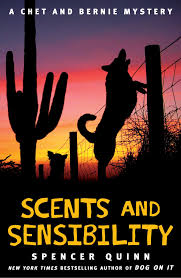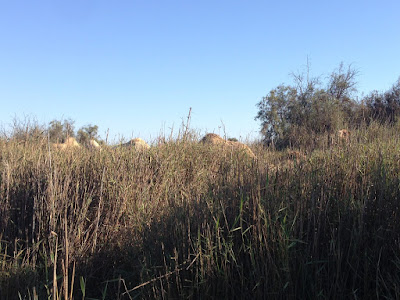Ha ha! It’s not a post about backpacking through the wilderness! ‘Hiking’ is shorthand (short-mouth?) for hitchhiking, which is how most people travel here. Even people with cars sometimes choose to hike rather than take on the however-many-hour drive to wherever. Peace Corps volunteers worldwide are banned from driving for safety. And our monthly allowance is too low to cover a car, owned or rented, anyway.
 |
J.'s knee position in a somewhat cramped extended car
(two rows of seats behind the driver, so the car seats eight
instead of five). We sat like that from Swakop to Okahandja,
fortunately just a gentle two-hour jaunt. |
Formal hiking only happens in larger towns. In Windhoek, for instance, there are four or more ‘hike points’ where a fleet of combis (vans), with the driver’s name, phone number and government license number on the side, offer rides in certain directions. You go to one hike point if you’re traveling south; a different one if you’re traveling east, etc. Someone’s sitting at a table collecting the fares. He (I’ve only seen men in this role) writes down your name and a contact number for your next of kin, and then you tell him you need a receipt about 20 times, and finally he gets you one and you pay him. While waiting for the receipt, you hand over any large luggage to a man (so far only men) who puts it in the large, open trailer behind the combi that’s currently loading, and you try to score a decent seat. Once the paying’s taken care of, you board the combi and wait until it fills up, and once it does it sets off – stopping after about 100 meters for gas. The whole process may take ten minutes or an hour and a half. Good luck.
Informal hiking is what most people do. In almost all towns, including the bigger ones, there are sites also called hike points where car-less travelers gather and drivers stop by to see what they find. Someone hangs his head out the window and says, “Windhoek,” and one person rushes forward while the others all shake their heads. They want to go to Rundu, or at least Otjiwarongo. Fares are pretty standardized, and maybe even official, but agreeing on the fare beforehand is important. Some drivers are open to negotiation (some just offer a ride out of kindness, sense of community, or the very-rare-in-these-parts environmental awareness), and a few will try to charge you double the going rate, especially once they realize you're not from here.
 |
I showed this little girl 'Itsy-Bitsy Spider' on a hike to
Okahandja, and she practiced her English on me. |
So here are a few hiking stories:
I had a meeting outside Usakos one morning, and planned to travel to Kunene region afterwards. One of my colleagues gave me a ride eastwards and a bit north to Karibib, where I could hitch a ride more north and a bit east to Otjiwarongo, where I could get a ride west and slightly south to Khorixas. Trying to get a ride directly north and slightly west from Usakos would require finding someone who would be jouncing the gravel roads through northern Erongo and southern Kunene regions, and all my advisors were certain my odds would be much better if I stuck to the more roundabout paved route.
In Karibib I waited a bit less than an hour, sitting on a low wall under a shady tree, while the local touts at the filling station flagged down potential rides for me and other travelers. I have no idea how these touts get paid. They found me a covered bakkie, and everyone fussed about cleaning the truck-bed up a bit for me, and I clambered in and slung my duffle behind me to be a bolster. It was perfectly comfortable, and I shared the truck with a lovely young man who said almost nothing all the way to Omoruru, where we stopped at another filling station and picked up, not another passenger, but a slightly manky foam rubber mattress to enhance passenger comfort. Lovely! I shared some gorp with my truck-bed-mate; I often share a cooky or orange segments or something with fellow hikers – and the driver if I can reach him.
 |
| Omoruru filling station; newly aquired mattress under us. |
The bakkie driver took me to yet another filling station in Otjiwarongo, where we learned the hike point for Khorixas had changed, so he drove me to the new location. What service. I waited a bit more than an hour there, and eventually got a ride in a car right to Khorixas. Well, a detour or two to drop off others. As the first one in the car, I was able to claim shotgun, while three strangers who moseyed up later smushed themselves into the back seat. The typical car here is about the size of a Celica or Civic, and drivers like to fill them right up. That driver knew how to get to the Ministry building I needed, and the way in through the back, so he gets a super A-plus.
To get back from Khorixas I went to a filling station at about 9:00 on Sunday morning and waited about 30 minutes until a double-cab bakkie headed for Walvis Bay – over the gravel roads – arrived. Fellow PCV J. and I established our rates and climbed aboard. Once again I scored shotgun. We waited about 15 minutes before a woman with two children and a single man joined us. (Children sometimes do and sometimes don’t count as passengers. Anyone available may be expected to take a lap child, who may be ten years old and 30 kilograms, if necessary.)
Our gentleman passenger needed to pick up something from a friend, so we left the filling station and headed in the wrong direction, stopping at a shop. The passenger vanished for about ten or fifteen minutes, and the driver eventually went looking for him. He found him in a shed; they shouted reasonably amicably to each other for a while; the driver returned; eventually the passenger returned carrying a bottle of wine and informing the driver that he knew four people who needed a ride just out of town and would travel in the back of the open pick-up bed. We drove around to find those people, and then there was some price negotiation, and eventually they all clambered into the back. Then – about 30 or 40 minutes after we’d left the hike point – we left Khorixas.
We put the back passengers down by a field somewhere after ten or twenty kilometers and carried on along the gravel road. Maybe 30 minutes later, the single man insisted the driver stop by a very small settlement, about six houses in the middle of nowhere, so he could buy more wine. That was another 15-20 minutes. The driver muttered and sputtered, but made the stop. “These Damara,” he said. “Always drinking.” “I am Damara,” the woman with the kids said, “and I do not drink at all.” The man returned eventually and explained that he needed the wine for his hangover. “Water is better for hangover than wine,” J. asserted. J. knows a few things about hangovers, I suspect. The guy argued with him.
 |
An entirely sober and very friendly Damara mama
on the way to Okahandja. Actually, she and the little girl
above went all the way to Windhoek. |
We let J. out at a gravel-road intersection with no traffic or human habitation in sight, and he told me later he got a safe and comfortable ride the rest of the way to Omaruru almost immediately. Score! The rest of us bounced along toward Hentie’s Bay, stopping once or twice to add oil and once to pull a rock out of the wheel well. The drunk guy was very helpful with that. We only came dangerously close to the ditch by the edge of the road once. So score, I think, for me, too. I got to Swakop healthy and injury-free with all my luggage about five hours after leaving Khorixas, and got a cab pretty quickly for a Sunday afternoon. Shotgun once again, until a large woman about half my age told me I’d have to ride in the back as her legs hurt.
One time I was waiting in a cab for Swakop; just me for a passenger, and a man walked up and told the driver he’d pay $150 instead of the usual $50 if the driver would leave immediately. Awesome! That’s the only time I’ve seen that.
 |
| A fully-packed car - I'm shotgun, one more adult on the right in the back. |
Coming back from Okahandja one time, I got a ride as far as Karibib, where I waited kind of a long time as the evening drew close. (PCVs and PC staff are not supposed to travel after dark, except on expensive, safe Inter-Cape buses and trains.) Eventually the Karibib touts found me a ride in a standard tiny sedan with a young man in mirror shades and a Fubu hoodie driving, and his similarly-attired friend in the passenger seat, and me alone in the back. ‘They’ (I kept thinking that it was really the two of them responsible for the driving, not just the actual driver) hit 180 km/hr at several points. However, they weren’t passing, braking or tailgating in crazy ways, all of which are common, so I just sat back and SMS’d a few friends. If I’d been worried I would have tried telling them there had been a lot of speed traps along this stretch of road recently.
One more: I got a ride to Okahandja with a man whose ancestors came to this area from the Netherlands and France, and who had served in the South African Defense Force during the war for independence. He seemed very much to resent the Namibian victory in that war and all its results. I did a lot of subject changing that ride. When he told me that “Their brains aren’t developed enough for business,” I replied, “No, that’s not it. It’s just a matter of education. Goodness, it’s a lot browner along here, isn’t it?” Everyone likes to talk about the drought. When he let me out at my destination, I pulled out my wallet to pay and he said, “No, you don’t need to pay. You needed a ride and I gave one.” “Thanks so much,” I said, and so we parted. At the end of the month I head for mid-service conference in Windhoek. Visualize a safe, swift, sane ride for me, please.










































